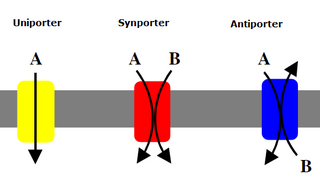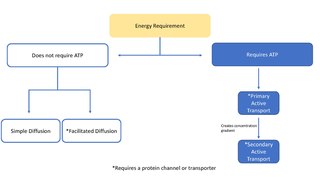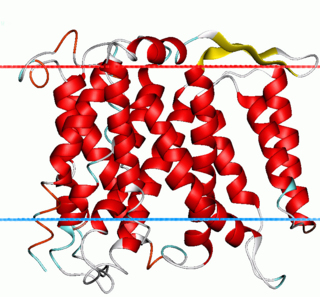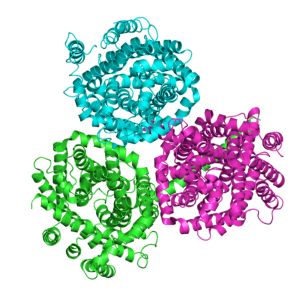Related Research Articles

An antiporter (also called exchanger or counter-transporter) is a cotransporter and integral membrane protein involved in secondary active transport of two or more different molecules or ions across a phospholipid membrane such as the plasma membrane in opposite directions, one into the cell and one out of the cell. Na+/H+ antiporters have been reviewed.
The Transporter Classification Database is an International Union of Biochemistry and Molecular Biology (IUBMB)-approved classification system for membrane transport proteins, including ion channels.

In biology, a transporter is a transmembrane protein that moves ions across a biological membrane to accomplish many different biological functions including, cellular communication, maintaining homeostasis, energy production, etc. There are different types of transporters including, pumps, uniporters, antiporters, and symporters. Active transporters or ion pumps are transporters that convert energy from various sources—including adenosine triphosphate (ATP), sunlight, and other redox reactions—to potential energy by pumping an ion up its concentration gradient. This potential energy could then be used by secondary transporters, including ion carriers and ion channels, to drive vital cellular processes, such as ATP synthesis.

The sodium–hydrogen antiporter or sodium–proton exchanger (Na+/H+ exchanger) is a membrane protein that transports Na+ into the cell, and H+ out of the cell (antiport).

Proteins of the Betaine/Carnitine/Choline Transporter (BCCT) family are found in Gram-negative and Gram-positive bacteria and archaea. The BCCT family is a member a large group of secondary transporters, the APC superfamily. Their common functional feature is that they all transport molecules with a quaternary ammonium group [R-N (CH3)3]. The BCCT family proteins vary in length between 481 and 706 amino acyl residues and possess 12 putative transmembrane α-helical spanners (TMSs). The x-ray structures reveal two 5 TMS repeats with the total number of TMSs being 10. These porters catalyze bidirectional uniport or are energized by pmf-driven or smf-driven proton or sodium ion symport, respectively, or else by substrate:substrate antiport. Some of these permeases exhibit osmosensory and osmoregulatory properties inherent to their polypeptide chains.

Members of the Solute:Sodium Symporter (SSS) Family (TC# 2.A.21) catalyze solute:Na+ symport. The SSS family is within the APC Superfamily. The solutes transported may be sugars, amino acids, organo cations such as choline, nucleosides, inositols, vitamins, urea or anions, depending on the system. Members of the SSS family have been identified in bacteria, archaea and eukaryotes. Almost all functionally well-characterized members normally catalyze solute uptake via Na+ symport.
The Ca2+:cation antiporter (CaCA) family (TC# 2.A.19) is a member of the cation diffusion facilitator (CDF) superfamily. This family should not be confused with the Ca2+:H+ Antiporter-2 (CaCA2) Family (TC# 2.A.106) which belongs to the Lysine Exporter (LysE) Superfamily. Proteins of the CaCA family are found ubiquitously, having been identified in animals, plants, yeast, archaea and divergent bacteria. Members of this family facilitate the antiport of calcium ion with another cation.
Divalent anion:Na+ symporters were found in bacteria, archaea, plant chloroplasts and animals.
The p-aminobenzoyl-glutamate transporter(AbgT) family (TC# 2.A.68) is a family of transporter proteins belonging to the ion transporter (IT) superfamily. The AbgT family consists of the AbgT (YdaH; TC# 2.A.68.1.1) protein of E. coli and the MtrF drug exporter (TC# 2.A.68.1.2) of Neisseria gonorrhoeae. The former protein is apparently cryptic in wild-type cells, but when expressed on a high copy number plasmid, or when expressed at higher levels due to mutation, it appeared to allow uptake (Km = 123 nM; see Michaelis–Menten kinetics) and subsequent utilization of p-aminobenzoyl-glutamate as a source of p-aminobenzoate for p-aminobenzoate auxotrophs. p-Aminobenzoate is a constituent of and a precursor for the biosynthesis of folic acid. MtrF was annotated as a putative drug efflux pump.
The ion transporter (IT) superfamily is a superfamily of secondary carriers that transport charged substrates.
Arsenite resistance (Ars) efflux pumps of bacteria may consist of two proteins, ArsB and ArsA, or of one protein. ArsA proteins have two ATP binding domains and probably arose by a tandem gene duplication event. ArsB proteins all possess twelve transmembrane spanners and may also have arisen by a tandem gene duplication event. Structurally, the Ars pumps resemble ABC-type efflux pumps, but there is no significant sequence similarity between the Ars and ABC pumps. When only ArsB is present, the system operates by a pmf-dependent mechanism, and consequently belongs in TC subclass 2.A. When ArsA is also present, ATP hydrolysis drives efflux, and consequently the system belongs in TC subclass 3.A. ArsB therefore appears twice in the TC system but ArsA appears only once. These pumps actively expel both arsenite and antimonite.
The Malonate Uptake (MatC) family is a constituent of the ion transporter (IT) superfamily. It consists of proteins from Gram-negative and Gram-positive bacteria, simple eukaryotes and archaea. The proteins are of about 450 amino acyl residues in length with 12-14 putative transmembrane segments (TMSs). Closest functionally-characterized homologues are in the DASS family. One member of this family is a putative malonate transporter.
The Basic Amino Acid Antiporter (ArcD) family is a constituent of the IT superfamily. This family consists of proteins from Gram-negative and Gram-positive bacteria. The proteins are of about 480 amino acyl residues (aas) in length and have 10-12 putative transmembrane segments (TMSs). Functionally characterized homologues are in the DcuC and ArsB families. Some members of the family probably catalyze arginine/ornithine or citrulline/ornithine antiport.

Na+/H+ antiporter A (NhaA) family (TC# 2.A.33) contains a number of bacterial sodium-proton antiporter (SPAP) proteins. These are integral membrane proteins that catalyse the exchange of H+ for Na+ in a manner that is highly pH dependent. Homologues have been sequenced from a number of bacteria and archaea. Prokaryotes possess multiple paralogues. A representative list of the proteins that belong to the NhaA family can be found in the Transporter Classification Database.
The NhaB family belongs to the ion transporter (IT) superfamily. A representative list of proteins belonging to the NhaB family can be found in the Transporter Classification Database.
The NhaC family belongs to the Ion Transporter (IT) Superfamily. A representative list of proteins belonging to the NhaC family can be found in the Transporter Classification Database.
The NhaD family belongs to the Ion Transporter (IT) Superfamily. A representative list of proteins belonging to the NhaD family can be found in the Transporter Classification Database.

The Monovalent Cation:Proton Antiporter-1 (CPA1) Family (TC# 2.A.36) is a large family of proteins derived from Gram-positive and Gram-negative bacteria, blue-green bacteria, archaea, yeast, plants and animals. The CPA1 family belongs to the VIC superfamily. Transporters from eukaryotes have been functionally characterized to catalyze Na+:H+ exchange. Their primary physiological functions are thought to be in (1) cytoplasmic pH regulation, extruding the H+ generated during metabolism, and (2) salt tolerance (in plants), due to Na+ uptake into vacuoles. Bacterial homologues have also been found to facilitate Na+:H+ antiport, but some also catalyze Li+:H+ antiport or Ca2+:H+ antiport under certain conditions.
The Monovalent Cation:Proton Antiporter-2 (CPA2) Family is a moderately large family of transporters belonging to the CPA superfamily. Members of the CPA2 family have been found in bacteria, archaea and eukaryotes. The proteins of the CPA2 family consist of between 333 and 900 amino acyl residues and exhibit 10-14 transmembrane α-helical spanners (TMSs).
The cation:proton antiporter (CPA) superfamily is a superfamily of transport proteins named after one of its constituent members, the monovalent cation:proton antiporter-2 (CPA2).
References
- ↑ Prakash, Shraddha; Cooper, Garret; Singhi, Soumya; Saier, Milton H. (2003-12-03). "The ion transporter superfamily". Biochimica et Biophysica Acta (BBA) - Biomembranes. 1618 (1): 79–92. doi:10.1016/j.bbamem.2003.10.010. ISSN 0006-3002. PMID 14643936.
- ↑ Lolkema, Juke S.; Slotboom, Dirk Jan (2003-04-11). "Classification of 29 families of secondary transport proteins into a single structural class using hydropathy profile analysis" (PDF). Journal of Molecular Biology. 327 (5): 901–909. doi:10.1016/s0022-2836(03)00214-6. ISSN 0022-2836. PMID 12662917. S2CID 22815736.
- ↑ Rabus, R.; Jack, D. L.; Kelly, D. J.; Saier, M. H. (1999-12-01). "TRAP transporters: an ancient family of extracytoplasmic solute-receptor-dependent secondary active transporters". Microbiology. 145 ( Pt 12) (12): 3431–3445. doi: 10.1099/00221287-145-12-3431 . ISSN 1350-0872. PMID 10627041.
- ↑ Sousa, Pedro M. F.; Videira, Marco A. M.; Vorburger, Thomas; Silva, Sara T. N.; Moir, James W.; Steuber, Julia; Melo, Ana M. P. (2013-03-01). "The novel NhaE-type Na(+)/H (+) antiporter of the pathogenic bacterium Neisseria meningitidis". Archives of Microbiology. 195 (3): 211–217. doi:10.1007/s00203-012-0856-4. ISSN 1432-072X. PMID 23208205. S2CID 1704372.
As of this edit, this article uses content from "2.A.111 The Na+/H+ Antiporter-E (NhaE) Family" , which is licensed in a way that permits reuse under the Creative Commons Attribution-ShareAlike 3.0 Unported License, but not under the GFDL. All relevant terms must be followed.